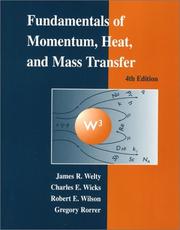| Listing 1 - 1 of 1 |
Sort by
|

ISBN: 0471381497 9780471381495 Year: 2001 Publisher: Hoboken, New Jersey : John Wiley & Sons, Inc,
Abstract | Keywords | Export | Availability | Bookmark
 Loading...
Loading...Choose an application
- Reference Manager
- EndNote
- RefWorks (Direct export to RefWorks)
Momentum transfer in a fluid involves the study of the motion of fluids and the forces that produce these motions. From Newton's second law of motion it is known that force is directly related to the time rate of change of momentum of a system. Excluding action-at-a-distance forces, such as gravity, the forces acting on a fuid, such as those resulting from pressure and shear stress, may be shown to be the result of microscopic (molecular) transfer of momentum. Thus, the subject under consideration, which is historically fluid mechanics, may equally be termed momentum transfer. The history of fluid mechanics shows the skillful blending of the nineteenth- and twentieth-century analytical work in hydrodynamics with the empirical knowledge in hydraulics that man has collected over the ages. The mating of these separately developed disciplines was started by Ludwig Prandtl in 1904 with his boundary-layer theory, which was verifed by experiment. Modern fluid mechanics, or momentum transfer, is both analytical and experimental.
massa --- warmteleer --- thermodynamica --- Thermodynamics --- Fluid mechanics --- Heat --- Mass transfer --- Transmission --- 536.24 --- -Mass transfer --- Electromagnetic waves --- Physics --- Cold --- Combustion --- Fire --- Temperature --- Thermochemistry --- Hydromechanics --- Continuum mechanics --- Mass transport (Physics) --- Transport theory --- Heat transfer. Heat exchange. Heat transmission --- Fluid mechanics. --- Mass transfer. --- Transmission. --- 536.24 Heat transfer. Heat exchange. Heat transmission --- Heat transfer --- Thermal transfer --- Transmission of heat --- Energy transfer --- Heat - Transmission --- Mécanique des fluides. --- Transfert de chaleur. --- Transfert de masse. --- Flow --- Momentum transfer
| Listing 1 - 1 of 1 |
Sort by
|

 Search
Search Feedback
Feedback About UniCat
About UniCat  Help
Help News
News